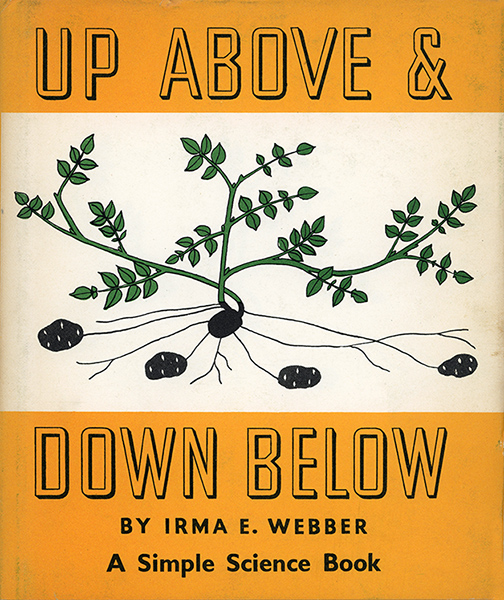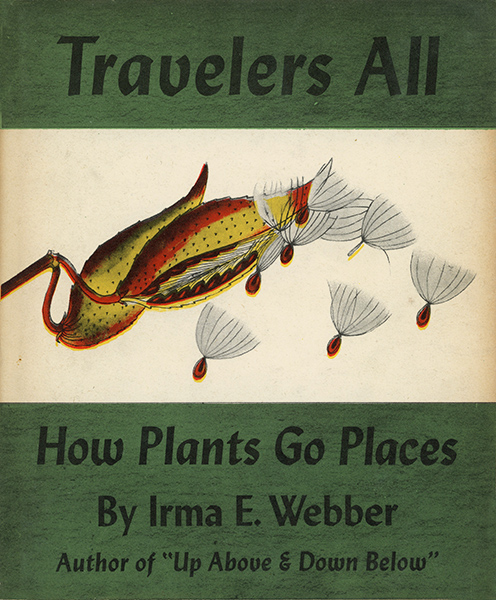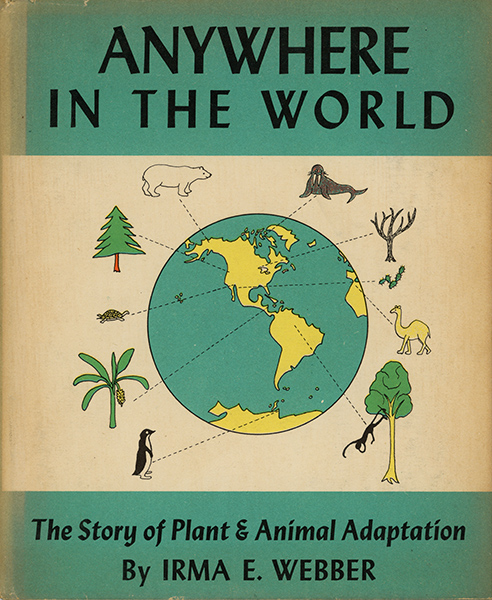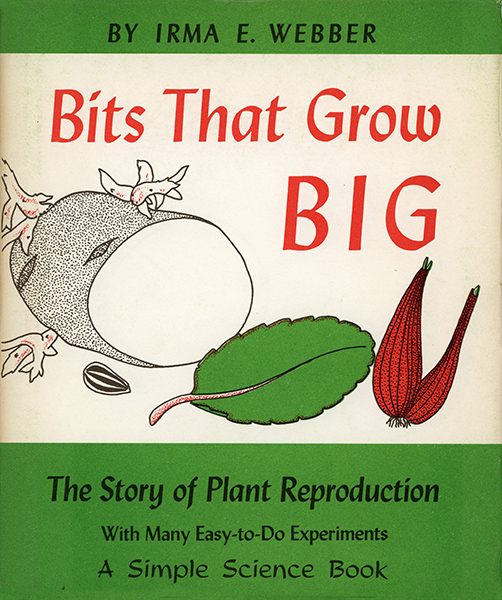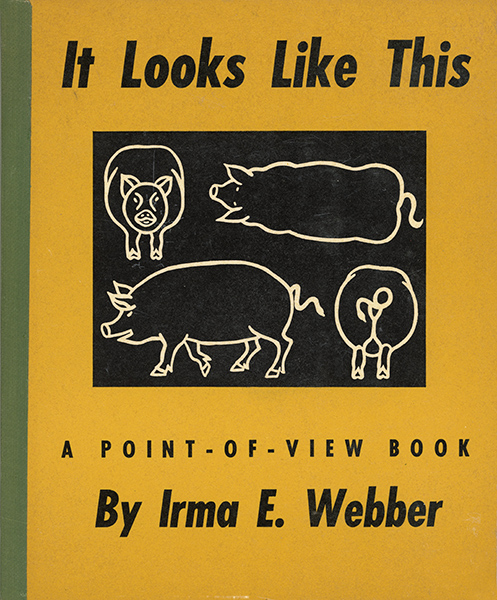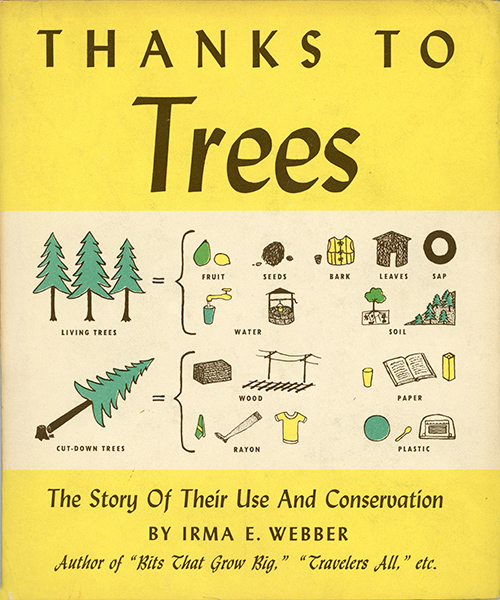|
speech text for City of Los
Angeles Board of Education, Nov. 15, 1944
My
little books, UP ABOVE AND DC·WN BLO'N and
TRAVELERS ALL, are the result of my being both
mother and botanist. While I was trained to be a
teacher, my teachers credential was of the
general secondary kind, and my teaching
experience was at the University of California.
For that reason, my views on science and books
for young children are based mostly on
experiences with my own children and their
friends.
Any mother of young children will tell you it is
a bit difficult to give her family the care it
needs, do the housework, and also pursue a
career. My idea has always been to simplify and
organize household tasks so that they will take
as little time as possible in order to have more
time for other things. As both my husband and
his father are also botanists, they understand
fully why botany should interest me, and have
always encouraged me to devote as much time as
possible to botanical studies.
When my son was a baby, I always reserved his
nap time for my study time. When he reached the
toddler stage and slept less, I often did
botanical work while he played. We had a large
enclosed back yard, and I used to send him
outside to amuse himself as he chose while I did
likewise. In this way I managed to accomplish a
good deal of scientific work despite frequent
interruptions. For Herbert kept coming in with
the request, "Mama, come see"., and I usually
felt that I should see what he had discovered.
Usually the thing that thrilled him was
something that most grownups wouldn't have
noticed, or would have taken thoroughly for
granted. I remember Herbert wanting me to see
clouds move in the sky, plants emerging from the
soil, flowers coming into bloom or falling to
pieces, birds pecking figs, earthworms, rocks,
and insects. And I'll never forget the look of
amazement on hie face when he came in all out of
breath to tell me, "Mama, kitty digs".
Sometimes when Herbert asked me to come see
things, he really wanted me to feel or smell, or
hear something. For he discovered that sunflower
leaves are rough, petunia leaves are sticky, and
rose leaves are prickly, that flowers don't all
smell alike, and birds don't all sound
alike.
When Herbert was four, Irma Jean was born, and
of course that meant , for a while at least, I
would be devoting more time to the family, and
consequently less to botany. In order to give me
a little time for uninterrupted botanical
research, my husband, on days away from the
office, would often take Herbert for a walk
while Irma Jean took a nap. When the walkers
returned I always heard about some of the
wonderful things they had seen. Sometimes it
would be ants, - ants that were red instead of
black, or great big ants that carried seeds even
bigger than they were. Sometimes it would be a
mud puddle, or the way the ground cracked to
form little cakes when the puddle dried up.
Usually, besides stories of interesting things
they had seen, there were pockets, bags, bottles
or cans full of samples. These included rocks
that glistened, rocks that were red or round or
smooth, or that a small boy could break with his
hands. And of course there were seed pods and
autumn leaves and bits of bark, and polliwogs
and pussywillows.
By the time Herbert was ready for first grade he
had a better knowledge of nature and much
greater appreciation of all sorts of natural
history objects than many men. He also had
formed the habit of telling what daddy says
about all sorts of things. This being so, I
probably shouldn't have been surprised when at a
P.T.A. meeting his first grade teacher told me
what was supposed to be a joke. She said that
one day somebody had brought a horned toad to
school, and Herbert, according to custom had
quoted his daddy on the subject of horned toads.
As she wanted to get off the subject of horned
toads and on with the class work that was
supposed to be done that day, she terminated
Herbert's remarks by saying, "That's fine
Herbert. You are a lucky boy to have a daddy
that can tell you about so many things. Some
parents can't do that, because they know only
about their own special kind of work." To that
she said Herbert replied, "Yes, that's right.
Now my daddy knows all about everything, but my
mamma knows just about wood."
Of course it was easy enough for me to see that
Herbert's statement was based on the fact that I
was in the habit of staying home to watch sister
and study the microscopic structure of woods
whenever Herbert and his father went forth to
explore Mt. Rubidoux. And I knew that no normal
six year old could possibly be as interested in
the minute structure of wood as in seeing a
ground squirrel run into its hole, or in
discovering that pine nuts are edible. It was
just a clear cut case of scientific
specialization being much [less] appealing to a
youngster than a general knowledge of nature
which made every day living pleasanter. But I
wasn't content to just realize this, laugh it
off, and let my son continue to regard me as
ignorant, and probably have my daughter grow up
with a similar opinion. It seemed that the best
way I could better Herbert's opinion of me was
to demonstrate that my interest in woods was
only a part of my interest in nature. So the
next time Herbert and daddy went for a walk,
Irma Jean and I went along. As Irma Jean was
only two, she wasn't able to walk very fast or
very far, but we all had a good time seeing
things and talking about them, and inaugurating
our family custom of taking walks together.
With nature walks an established part of our
family life, and a two year old daughter that
didn't like to play alone when brother was at
school, I would have had practically no time for
botanical research if Dr. Gertrude Turner
Huberty hadn't established a small but very good
nursery school for the benefit of her own
children. At this nursery school I knew that
Irma Jean was thoroughly happy and in very good
hands, and while both children were in school I
had a few hours each day for real concentrated
botanical endeavors. But this wonderful set-up
came to an end. The Hubertys moved to Los
Angeles. One of Dr.Huberty's assistants bought
her nursery school equipment, and for a while
ran the nursery school at her home. But before
Irma Jean was four, the school closed. As Irma
Jean craved companionship and was very unhappy
about having to stay at home instead of going to
school, I tried to cheer her up by amusing her
in various ways. She helped me do the housework
and cooking,we worked together in the garden,
played little games, drew pictures, painted, and
of course read books. As plants and animals were
among Irma Jean's major interests at the time, I
tried to get some informational books about
plants and animals that would appeal to her. I
soon discovered that the field of science books
for very young children hadn't received the
attention I thought it should have.
Gradually it dawned on me that it might be a
good plan for me to shift my interest from
intensely technical publications to science
books for young children. It seemed to me that
by so doing, I would be able to spend the time I
liked to spend looking at nature's marvels with
my children without ever questioning that such
time was being spent to beat advantage. Also, I
was convinced that books of the type I had in
mind would be at least as worthwhile a
contribution to society as any of the technical
botanical papers I had written or might write.
UP ABOVE AND DOWN BELOW was my first book
venture. When it was finished, I got a writer's
magazine listing the interests of various
publishers, picked a place to send the
manuscript, and waited hopefully. After several
weeks it came back, express collect, with
a standard printed rejection slip. In the months
that followed, I acquired what would have been a
discouraging collection of these, if they hadn't
been interspersed with words of praise from
various editors who hoped I would have luck in
placing the manuscript with some other
publisher. Such editors letters made me realize
that publishers are in the publishing business
for profits, that colored picture books are
expensive to produce, that competition in the
field of children's books is keen, and that
books on special subjects do not have as large a
sale as those of a more general nature. Fully
aware of all these things, I sent UP ABOVE AND
DOWN BELOW to William R. Scott Inc.,
Naturally I was thrilled when their editor Mr.
McCullough, wrote that he liked it and wanted to
keep it with the idea of trying to fit it into
their publishing program at some future time.
And I was thrilled again, when Mr. McCullough
wrote that they would publish it if I made
certain changes necessary for more economical
manufacture. These involved changing the book
from one bound at the top to one bound at the
aide, making the story fit into thirty two
pages, and doing over the naturalistic
illustrations so that the book would not require
more than three colors. Mr. McCullough offered
some helpful suggestions as to how to go about
all of these things, and accepted UP ABOVE AND
DOWN BELOW for publication when they were done
to his satisfaction. So, nearly three years
after I had completed the original manuscript,
my first book went on sale. As I had sold all
rights in the book to William R. Scott Inc., it
supposedly wouldn't make any difference to me
how well the book sold. However I was hopeful
that it would sell well, For I felt that it was
really a trial balloon that would indicate the
demand for the sort of books I thought I might
produce. And also, I was hopeful that a
publisher brave enough to accept a manuscript
that had been turned down by so many others,
presumably because it would be unprofitable to
publish, wouldn't lose too heavily on the
venture. Accordingly, I was delighted when Mr.
McCullough wrote that the book selling so much
better than they figured it would, that they
would be able to give me a new contract
stipulating payment of royalties and an option
on my next two manuscripts.
TRAVELERS ALL went directly to William R. Scott
Inc. and Mr. McCullough accepted it. However Mr.
McCullough went into the army before deciding
what changes would have to be made in the
manuscript before it could become a Young Scott
Book. Mr. Scott was responsible for editing this
one, and barely finished the job before he too
went into the army. He felt that tryouts
indicated that children would like it at least
as well as UP ABOVE AND DOWN BELOW, and the
sales record of that book indicated that there
probably would be sufficient demand for
TRAVELERS ALL to permit using four colors in it.
Naturally I am hoping he was right about this,
for it is only as this type of book proves that
it isn't a money loser for the publisher that
others of similar nature will be published. From
my own standpoint, the financial returns for the
time spent are certainly not very great. My
greatest rewards for work of this type are
pleasure in the work itself, and feeling that my
little books are filling a welcome spot in the
lives of children, and perhaps even in the lives
of their teachers and librarians.
|
|
|
